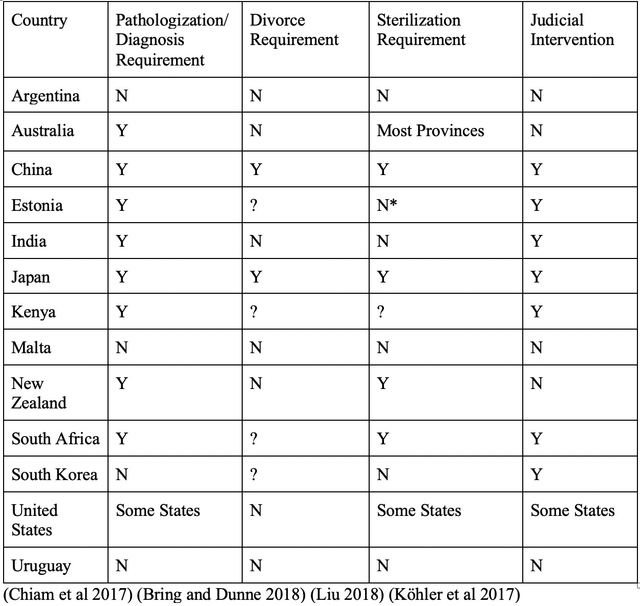The Process and Barriers to Legal Gender Transition: A Case Study Analyzing the Yogyakarta Principles
By
2020, Vol. 12 No. 07 | pg. 1/1
IN THIS ARTICLE
KEYWORDS
AbstractTrans people experience a wide range of social and legal disadvantages, including an inconsistent, patchwork system - where one exists at all - to attain legal recognition of their gender. In the absence of such legal recognition, transgender people face more difficulty in navigating social or organizational institutions (ie bars, locker rooms, airports, care facilities, prisons, and other places that are sex-segregated or require an ID), less control over their healthcare, and a lower ability to gain and retain employment. Many states require one or more surgeries (including but not limited to: orchiectomy, penectomy, hysterectomy, double mastectomy, oophorectomy, phalloplasty, metoidioplasty, vaginoplasty) before a trans person can be legally recognized as a gender other than that assigned at birth. This paper borrows concepts from queer theory and trans theory to argue that these mandatory surgeries constitute an inhumane and indefensible barrier to legally transitioning. These surgeries are invasive, expensive, difficult to find in many places, irreversible, and in some cases sterilizing. Those who want surgeries that line up with legally-mandated definitions of their particular gender oftentimes cannot obtain it, as trans people are among the most under-resourced population globally; to require an inaccessible surgery creates a paywall to obtaining their full rights. Additionally, though, many trans people do not want "the surgery" (whichever one from the list is required by their government) for a variety of reasons, and requiring them to get such surgeries in order to obtain official gender recognition is legally-mandated mutilation. The Yogyakarta Principles provide a superior framework for the legal recognition of trans people, and many pieces from the principles have been successfully drafted and implemented in Uruguayan law. Legal and social organization in civil societies globally has been in part structured by a supposed gender binary. In order to identify and classify certain groups of people, characteristics associated with sex at birth such as genitals and chromosomes have been paired into two categories: male and female. As people mature, they are socialized to embody traits associated with male or female, depending on what they were assigned at birth. The performance of these traits is known as gender, which is a term often used interchangeably with sex. This strict categorization of human beings is completely disrupted by individuals who are not born with sex characteristics that match exactly what male or female have been described as. Those people (who are typically referred to as “intersex”) alone are proof that the sexual binary is not an innate part of nature; if the binary were true, there would be no outliers. There are additionally people who don’t conform to the gender binary assigned at birth, often referred to as transgender people. Transgender people are assigned a particular sex (and therefore gender) at birth and are typically socialized as children to perform traits of this assigned gender. As they age, trans people start to identify and perform another gender that isn’t associated with their sex and usually seek to transition in order to align closer their internal experience and their outward social presence. Trans individuals existed before the classical definitions of sex arose in the 20th century (Vincent and Manzano 2017) ie third-gender people of ancient India (Michelraj 2015) and contemporary Hijras (Singh et al. 2014), “two-spirit” Native Americans (the term “two-spirit” being a pan-Indian term to describe a multiplicity of gender variance across Native American cultures) such as napêhkân and iskwêhkân people of the Cree (Vowel 2016), the many individual examples of what could be described as binary transgender people in European history such as the Roman emporer Elagabalus who was most likely a trans woman (Varner 2008, 201), the trans man who lived as a monk after fleeing Constantinople in the 6th century (Conner et al 1997, 57), Eleanor Rykener, a trans woman in 14th century London (Dinshaw 1999, 101), Karl Maher, one of the first modern examples of a legally-affirmed trans man in 1907 (Brennar 2008, 174), the list goes on. The concept of the gender/sex binary is relatively new, but current societal organization functions as if it has always been a part of human nature. Trans individuals are difficult to socially and legally organize in this rigid binary system. As a result, there are discrepancies in most states’ legal systems that directly harm trans individuals, and their rights of self-determination. I will be analyzing the legal structures trans people must navigate in order to live as their gender.Jessica Clarke’s illuminating article “They, Them and Theirs” takes a look at the ways in which laws can be edited in certain contexts to most fully include the wide array of gender identities that human beings experience. There is no catch-all solution that would fully incorporate trans individuals into the current global binary, but with things like inclusion in currently-existing systems, abolishing some sex-segregated spaces, erasing the need for sex classifications in some cases, etc. trans individuals can both have their identities respected and enjoy the legal freedoms that civil societies have created. This is not a utopian project, as countries like Uruguay and Malta have robust inclusion laws for trans individuals, as will be discussed later. The primary focus of this paper, though, is analyzing laws dealing with legal gender transition. Transgender people must be able to legally affirm their gender in order to live a life that has substantially less barriers to self-determination. In order to legally affirm one’s gender in most states, there is a requisite surgery that is based on antiquated notions of a physical binary between sexes male and female. Assuming a trans person willingly elects to having one of the surgeries listed in order to legally transition, they first need a source of income to pay for it, housing to recover afterward, a support system to be able to transport them to and from check-up appointments, an already-healthy enough body to be able to deal with the repercussions of whatever surgery was legally necessary, and finally time to be able to have said appointments, surgeries, recovery, etc. These resources are hard to come by for trans people, often because their gender identity doesn’t match their currently-existing documents. This creates a Catch-22 where trans people have to get “the surgery” to be legally affirmed, but must be legally affirmed in order to have a chance at building up the resources to afford “the surgery.” It’s a cycle, and it is inhumane to under resource trans people then remove access to the pieces of documentation that could potentially be life-saving. Even if every country implemented universal health care, though, and trans people could receive one of the surgeries to legally affirm their gender without disrupting their ability to work, their access to shelter, etc., these requirements are still inhumane. There are many ways to transition (medically, socially, performatively), and there are a variety of both physical and psychological reasons for not desiring full genital-altering surgery. Sometimes, medical transition can lead to more bodily dysphoria for trans people. Since there is no innate sexual binary, there is no innate way to exist as a particular sex or gender. What is additionally egregious about requiring these surgeries is that full genital reconstruction surgery permanently sterilizes those who receive it. Trans people should be able to have the right to start families if they so choose, and requiring them to “change their sex” in order to legally align with their gender forces them into another impossible decision between giving up their right to biologically reproduce and existing in a world where they don’t have potentially life-saving documentation. Medical transition is thus completely inhumane to require for changing gender documentation. Global human rights advocates have thought of legal ways in which this problem can be addressed, which has resulted in the drafting of the Yogyakarta Principles. The Yogyakarta Principles seek to reinterpret existing international human rights law in the lens of sexual orientation and gender identity issues, in addition to creating new sets of trans-specific clauses for currently-existing international human rights documents. These principles are worth analyzing because of their specificity and clarity. Additionally, Uruguay will be used as a case study, as it is a global leader in transgender legal rights. This paper takes no interest in the metaphysical debate over trans existence; trans people have been around for ages and have been describing their own experience accordingly. While there is a growing body of trans-affirming work, there is an equally large body of work which seeks to demonize, belittle, and invalidate trans people. Trans people exist, I do not seek to explain why, and we should seek to structure a world in which they can have as much of a right to self-determination as their cisgender counterparts. Thus, any arguments about the validity of trans people’s experience of gender will not be addressed in the article. Literature ReviewThe language describing the surgery trans people receive as part of their transition has been trending towards “gender confirmation surgery” or “gender affirming surgery” or “bottom surgery” to replace the outdated “sex reassignment surgery” or “sex change.” As queer and trans theorists have contended for some time, gender and sex are not interchangeable concepts (Prince 2005). Additionally, neither sex nor gender are natural binaries (Madden 2018)--they are products of scientific and social constructs used to more easily organize people (Lorber 1993) (Butler 1999). Thus, having genital reconstruction surgery would therefore not be appropriate to refer to as “gender confirmation/affirmation” because genitals do not innately constitute gender. Thus, I will try to refer to the specific surgeries by name that are legally mandated for people to transition ie orchiectomy, vaginoplasty, penectomy, phalloplasty, metoidioplasty, hysterectomy, etc. rather than using the universal term “gender confirmation/affirmation surgery.” The list of surgeries that are associated with transitioning often have long-lasting consequences. They are medically difficult for bodies to adjust to, and some result in permanent sterility. When done without proper consent, sterilization is regarded as an egregious violation of a person’s physical integrity (UN Human Rights Council 2015). This knowledge will help understand the gravity of the situation trans people are facing when navigating vague laws around their legal transition. One of the dominant bodies of research in trans studies is the relationship between transgender individuals’ ability to navigate daily life in institutional contexts and having their gender legally recognized on official government documents. It is notably more difficult for transgender people to attain economic security in part because their legal documents do not correlate with their gender (Clarke 2018). Trans people have a harder time securing employment and retaining employment in part because of social discrimination and mis-matching documents outting them immediately (James et al. 2016). Trans people are more likely to live without homes (Eisenberg et al 2016), less likely to have access to mental health treatment (Christian et al 2018) (Zhu et al. 2019) (Valentine and Shipherd 2018), and less likely to seek preventative healthcare due to a fear of mistreatment and discrimination than cisgender people (Kohler et al 2017) (Liu 2018). Correct legal documentation is especially crucial in emergency situations, and transgender people have often been denied access to shelter, food and travel during natural disasters or situations of high security because their mismatched identity and documents are interpreted as fraudulent or suspicious (Chaman 2008) (Laguerre et al. 2010) (Saleem 2011). In much of the research and reports about trans people, it is clear that there is a correlation between not having the proper gender reflected on documents and having a significantly more difficult time navigating daily life. This data is partially incomplete, and trans people would greatly benefit from more research, attention and funding (Reisner et al 2016) (Poteat et al 2016) (MacCarthy et al 2017). The Process of Legally Transitioning and Why it is InhumaneAs it stands right now, there is no piece of international human rights legislation accepted/adopted by the UN that refers to trans people at all. Consequently, there are varying levels of trans-inclusive laws globally. The map below illustrates the countries where trans people can legally transition. There are many places in the world like Canada, West Asia, and most of Africa that have no existing laws that make it clear whether or not trans people can legally transition. Mongolia, Egypt and Venezuela have explicit laws forbidding transitioning in the first place. There is no global standard on what trans legal rights should look like, which is troubling for many trans people. This map only takes into account federal laws regarding transitioning. In places like the United States, it is possible to obtain a federal-instated ID such as a passport that accurately reflects a trans person’s gender, but this law is different at a state level. State-instituted driver’s license laws vary wildly, and for some trans people, this makes freedom of motion much more difficult because they could have an accurate passport, but an inaccurate driver’s license and/or birth certificate. Additionally, the rules for obtaining said documents vary; in some states, full “sex-reassignment surgery” (the definition of which is unspecified) is required in order to simply amend a birth certificate. In others, a trans person can self-identify as another gender and be assigned a completely new birth certificate by a state. In other countries than the US, a trans person has to be lucky enough to have a judge who deems them as “passing” enough as their correct gender in order to possibly receive newly-amended documents reflecting their gender. Below, I have created a table listing out some of the requirements commonly associated with transitioning. I have created this table myself to show that, even at the federal level, laws regarding transitioning can be contradictory or non-universal. I have taken at least one country from every continent. The countries in this table technically allow trans people to transition on some level, and I don’t take into account countries that don’t allow legal transition at all. Additionally, all these procedures and laws are assuming that trans people are transitioning to either male or female This excludes a singificant amount of transgender people who are nonbinary: those whose gender identity does not coincide with male or female. “Nonbinary” is an umbrella to describe a multiplicity of identities including but not limited to: agender (no gender), bigender (having more than one gender), gender fluid (one’s gender is in flux) etc. There is no uniform way to legally express a nonbinary identity because there is no singlular definition. Thus, nonbinary trans people are left with even less legal protections, as in most countries the option doesn’t exist at all to legally transition. For some nonbinary people, conventional surgical procedures including hysterechtomies, orchiectomies, mastectomies, penectomies, vaginoplasties, metoidoplasties, phalloplasties, etc. can be a great source of comfort in alleviating dysphoria. However, there is hardly any legal justification for acquiring these surgeries under insurance because there is no legal gender that they seek to “affirm.” As it stands now, there are hardly any countries with legal definitions of nonbinary, let alone agender, bigender, demigender, etc., and transitioning to more align oneself to any of those particular identities is thus not legally recognized. When a binary trans person decides to go through the process of legally transitioning, their current marital status, age or relationship with their family could prevent them from doing so. In Japan and China, a trans person must be unmarried in order to legally transition, as same-sex marriage is not yet legal. Any married person in these places who is a binary transgender person is legally in a heterosexual marriage, and transitioning would mean becoming the same sex as their current partner. Thus, they are required to get a divorce if they seek to transition. Minors in most countries are not allowed to transition at all, regardless of familial consent. In China, though, familial consent may also apply to transgender individuals over the age of 18. Adults must also receive either familial consent or approval from their current place of education or employment in order to transition (Liu 2018). For many trans people, familial relationships are in peril because being transgender is not considered socially acceptable (Saeidzadeh 2019). Thus, the familial requirement is contingent upon a trans person coming from an accepting family, which in many cases is untrue. This would effectively stop a trans person from being able to legally transition. Assuming, though, that a trans person is single, over the age of 18 and/or has family consent to transition, they must visit a doctor and receive a diagnosis of Gender Identity Disorder. In places like China, Japan and Mexico, a transgender person must first receive an official diagnosis of Gender Identity Disorder (GID) and have records of the diagnosis persisting for years before being allowed to legally transition. “Gender Identity Disorder” is an example of cisgender people pathologizing trans identities, which is reductive and a failure to recognize the full breadth of the human experience (Castro-Peraza et al 2019) (Franklin 2018), but many transgender people have to receive it anyway in order to have “evidence” of their gender identity and thus be able to legally transition. On the one hand, GID is useful for trans people who want or need “proof” to transition and are then allowed to transition once they receive this diagnosis, but many trans people don’t have the resources to get to a person who can diagnose them, or even a person who would be willing to diagnose them in the first place (Singh et al 2014) (Byrne et al 2015). Additionally, a non-cisgender identity is not a disease or disorder of the mind, and should not be treated as such. Doing so is part of the inhumane process that trans people around the world have to go through in order to obtain life-saving documentation. Once a trans person does receive and retain a diagnosis, they must undergo medical intervention to secure “proof” that they have transitioned. There is no universal definition for what surgery or what kind of medical intervention must be done in order to prove one’s status as a different gender, which creates more confusion and barriers for people attempting to fully legally transition. In places like Estonia, Lithuania, and China, “surgery” is not defined at all. In Estonia and Lithuania, there is no sterilization requirement, meaning trans people can in theory undergo, for example, facial feminization surgery, hormone replacement therapy, hip masculinization surgery, etc. which leaves their genitals--and--fertility in tact. In practice, though, this is not how the law is interpreted because the process of transitioning is not an administrative one in these places, but a judicial one. Judges have not deemed most trans applicants the ability to legally transition without full genital reconstruction surgery. Countries like South Africa and Australia require the person transitioning to have “genitals that reflect the sex they are transitioning to,” which typically implies that trans women must have vaginas and trans men must have penises. Implicit already in these surgeries is a sterilization requirement, even if it is forbidden or unspecified in the law. In order to surgically construct a neovagina, one’s testicles and penis must be removed which leaves the person infertile. In order to construct a neopenis, the vagina must be completely restructured, which has the same effect: infertility. Thus, requiring people to surgically alter their genitals is a sterilization requirement couched in upholding the rigid sex and gender binary. Japan, Finland, New Zealand and other countries have laws explicitly requiring sterilization to transition. For people designated male at birth, this would mean an orchiectomy (removal of testicles) and usually a penectomy (removal of the penis) and for people designated female at birth, this would mean they have to get a hysterectomy and oophorectomy (removal of uterus and ovaries). There is no veil of the sexual binary to hide this law; it’s blatantly about limiting the reproductive functions of gender-variant people. It limits trans people’s rights to reproduce, completely unmasked from the previous argument that certain genders must have certain sex characteristics. These laws are the most egregious, and they are pervasive across the globe. When parsing through the logic of binary sex classifications being necessary to organize society, the argument about trans surgery becomes one about the validity of trans people's experiences. On the one hand, most would agree that mandatory sterilization of a specific population is, to put it non-academically, bad. Hardly any genuine, credited sources of academic thinking advocate for eugenics, so that is not where the argument goes in trans discourse. However, many in this case tend to argue that because trans people are willingly electing to change their gender legally, they are not therefore being required to be sterilized. They are consensually transitioning, and medically transitioning is an inherent part of being their gender. Since most people elect to having at least some form of medical intervention in their transition, it therefore makes sense to require surgery to reconstruct their genitals in order to be legally documented as the gender they want to be anyways. It bears mentioning again that trans people are being systematically failed by the social structures set up by and for cisgender people, which makes their “choice” to legally affirm their gender much less based in free-will. Said structures highly favor those whose gender aligns legally and personally, so most countries and states reward legally transitioning. It is an extremely difficult choice to make as a trans person; live without proper legal documentation and risk getting outed whenever applying for jobs or scholarships, getting denied the right to access sex-specific centers for domestic abuse survivors, getting harrassed and abused at bars or other age-specific events, etc or receive a life-altering surgery that results in permanent sterilization, weeks of recovery time and pain, huge financial burden, and possible loss of congruency of one’s physical body and psychological experience of gender. This is a choice that is not made of full free-will because the factors impeding the decision are far too many, and it is impossible to say that the decision is made with free and fair consent. Even if there were suddenly no barriers in accessing, receiving, and recovering from full genital reconstructive surgery, it is still an inhumane requirement. To be legally affirmed as their gender and be afforded certain rights, trans people have to receive a sterilizing surgery. This is a thinly veiled eugenics practice disguised as a natural argument for the sexual binary. Trans people do not have the right to choose whether or not they get to naturally conceive children if they choose to abide by the law and get a sterilizing surgery to be legally recognized as their gender. They cannot exist with the genitals they were born with; the country/state government demands that they legally alter and declare their genitals so that they can be afforded the rights of the gender they truly are. The Swedish Administrative Court of Appeals, Germany’s Constitutional Court and Austria’s Administrative High Court have all acknowledged and publicly stated that requiring surgeries which sterilize trans people in the process of legal gender recognition are unlawful and inhumane (Byrne 2013, 24). All of these courts in some way have acknowledged that this surgery is an infringement on human rights of bodily autonomy. Yogyakarta Principles and Uruguay: A systematic comparisonTo address the injustices against trans people present in so many countries, a group of human rights advocates from around the world drafted the Yogyakarta Principles. The Yogyakarta Principles are intended to add on to existing UN international human rights documents, so that countries can have more concrete ways to ensure that issues surrounding gender identity and sexual orientation are properly addressed. The principles have been presented and swiftly rejected by the UN, so these are not at all binding pieces of legislation. It is worth it, though, to examine them and see their applicability, especially because more than one country has successfully implemented nearly-identical laws. Wherein most countries don’t have trans-specific laws, this would act as a guide in drafting them, or interpreting currently existing laws. Uruguay has a vigorous set of laws specifically applying to transgender people. The country has a checkered history with social progressivism. Uruguay decriminalized homosexuality in 1933, one of the earliest countries to do so, but they also had a military dictatorship that lasted between 1975-1985 wherein transgender people were specifically targeted, harassed, disappeared and murdered. This was the time that the coalition of leftist parties, later known as the Frente Amplio, built up a grassroots campaign centered mostly on economic justice. It took years after the military dictatorship before any institutional changes were made to allow trans people any semblance of legal rights. Sexual orientation and gender identity (SOGI) rights groups fought for institutional change through grassroots organizing, understanding that these issues would only gain traction if they were paired up with feminist and racial rights groups. To ensure more support for their cause, SOGI groups used intersectionality to their advantage (Townsend-Bell 2013). The Frente Amplio has held some parliament seats since 1994, and won the presidency in 2004. They have remained in power since then, and have enacted a sweeping body of trans-related legislation starting in 2009. The Frente Amplio’s control of Uruguayan politics in both the presidency and later parliament has resulted in strides in marriage equality, abortion rights, and key in this discussion, gender identity self-determination. In 2009, the law was such that trans people could legally acquire accurate documents, a quite progressive law for the time. Since October of 2018, though, trans people can self-identify thanks to a landmark piece of legislation called Ley Integral Para Personas Trans. Below is a detailed comparison of articles from Ley Integral Para Personas Trans (LIPPT) and the Yogyakarta Principles. LIPPT begins with everybody’s right to self-determine their gender identity, which is highlighted many times throughout the Yogyakarta Principles. This emphasis on self-determination lays the groundwork for banning practices of inhumane requirements to legally transition. Additionally, by uncoupling the need to have one’s gender identity line up with “biological, genetic, anatomical, morphological, hormonal assignment or other sex” Uruguay can specifically serve the needs of trans people without having to have them “pass” in front of a judge. The LIPPT and Yogyakarta Principles have a nearly identical definition of gender identity, but both emphasize that gender identity is not aligned with sex assigned at birth. Most importantly, though, they both outline that trans people must freely choose to transition. Trans people have the right to functionally exist on their own accord, without being told by the state how to transition in order to be legally recognized. This opens up options for trans people who either can’t medically transition or choose not to. The Yogyakarta Principles statement that procedures are to be “efficient, fair and non-discriminatory” could mean something different in each country; in Uruguay, this looks like having the process of legally transitioning last no more than 30 days after the request is submitted, and creating a specific administration to facilitate that process rather than having it go through a judicial court. Where Uruguay is arguably potentially discriminatory is where said administrative body could potentially reach out to a trans person’s public and private contacts in order to ensure their gender identity is consistent in both the public and private sphere. This may be interpreted as a breach of a trans person’s right to self-determination because the Honorary Advisory Committee for Change of Identity and Gender must put together a report validating a trans person’s self-determination. Considering, though, that this report is predicated on how a person identifies instead of observing physical characteristics, this is perhaps not too egregious an example of administrative overreach. Here, the LIPPT specifically lays out that a trans person may change their gender in their legal documents and enjoy said freedoms of having their correct gender on their legal documents. This again adds to what the Yogyakarta Principles lay out. Again, this is an example of creating specific legislation to address a problem that is implied in the Yogyakarta Principles. Trans people need a robust system of inclusion and support in order to participate in the education system, which is rife with social discrimination all around due to trans people’s continued stigmatization. In fact, Article 17 stipulates specific amounts of scholarships for trans people. It stipulates: The organizations, agencies and institutions that assign scholarships and student support at national and departmental level, whatever their source of funding, should provide for quotas of 2% (two percent) for trans people... The Ministry of Education and Culture...will grant a minimum of 8% (eight percent) of the fund to trans people, which in any case ensures at least one quota. If there are not enough applicants within this quota, the remaining resources will be used for the rest of the candidates. This is a direct, specific way to give support to transgender people pursuing education. More importantly, this is a policy that is very specific to Uruguay, but could be interpreted differently in many other countries should the Yogyakarta Principles be adopted by the UN. This quota set forth by the LIPPT is an encouraging step forward in setting up robust mechanisms for transgender people to have access to work. Given that workplace harassment and discrimination is rampant, having a law which sets aside jobs for trans people in the public life is a good step for both visibility of trans people and financial security for those working the positions. Confidentiality of data and informed consent are highlighted in both documents as being crucial to a trans person’s medical experiences, whether said medical experience is related to transitioning or not. Trans people often have a more difficult time navigating healthcare settings because of the idea that sex and gender are synonymous, and the deconstruction of 20th century scientific ideas about sex and gender is still not institutionally universal. Here, the LIPPT repeals its piece of transgender-related legistlation from 2009. The 2009 law stipulates that transgender people must live as their gender for at least two years before being allowed to legally transition, which is no longer the case. Additionally, instead of making the process a judicial one as it was in 2009, it is now a fully administrative process. There are no eligibility criteria for transitioning, as mentioned in the Yogyakarta Principles 31c, and there is no minimum age to begin transitioning. Parental consent is required before transgender-related surgical intervention if desired by children, but acknowledging that many trans children are reared by unaccepting families, the LIPPT stipulates that such children can receive consent from another guardian party. There are pieces of the 2018 Uruguayan law that are not covered in the Yogyakarta Principles because they are country- and history-specific. For example, Article 10 and Article 11 lay out a detailed plan of financial compensation for transgender people born before the year 1975 who can credibly prove that the military dictatorship at the time was a severe hinderance to their life. While this isn’t the most groundbreaking reparations law, it still legally acknowledges the country’s history and treatment of transgender people and seeks to rectify it in some way. There are many other ways to do this, but Uruguay is the only country to enact this kind of reparations to transgender people. Additionally, Article 5--Visibility states that transgender people will be counted in Uruguayan censuses and other governmental statistical analyses from now on. This ensures that the government can assess the growth and subsequent needs of its transgender population, one of the many benefits of being included in a census. More data about trans experiences is one of the things researchers cite as the biggest need to improve research on transgender people. There are some aspects of the Yogyakarta Principles, on the other hand, that address the needs of trans people that are unaddressed in Uruguay, most notably the needs of nonbinary transgender people. Article 31c ii. of the Yogyakarta Principles requires countries to “Make available a multiplicity of gender marker options; ” which is not available in Uruguay. This is crucial as a growing number of transgender people are nonbinary; they too need legal protections. Making available a wider number of gender markers could be beneficial--though, in Iran, this third gender marker came with its own social stigma that prevented people from using it in the first place (Saeidzadeh 2019). Thus, if Uruguayan lawmakers were to implement this aspect of the Yogyakarta Principles, they would have to pay careful attention to the rights and liberties that come with the multiplicity of gender markers. Both the LIPPT and the Yogyakarta Principles have nearly identical ideas for trans liberation, but they were written completely independently of each other. Social change for trans people in Uruguay did not come from a large, international regulatory body crafting laws for their national government; rather, Uruguayans fought for these changes through hard work and intersectional organizing. Uruguay is a small, historically leftist country which is not what most countries in the world are. Thus, should the Yogyakarta Principles be adopted by the UN, they could provide activists and/or governmental legislative bodies in other countries a blueprint by which they should create their laws, rather than having to create them from scratch or by replicating the laws in a completely different country. ConclusionMany trans people do not have consistent, uniform and fair laws allowing them to freely exist as their gender in their country. Their path to obtaining accurate legal documentation, if it exists at all, is full of difficult decisions that do not allow for true freedom of expression or self-determination. Consequently, not having complete proper legal documentation as their gender puts trans people in a position of social vulnerability, hinders freedom of motion and expression, and can be life-threatening in situations of high-security. “Gender Identity Disorder” must no longer be a required piece of legally transitioning because it is a pathologization of trans lives, making their gender into a symptom of a problem rather than acknowledging it as a part of human existence. Mandatory surgery as a requirement for transitioning strips people of their basic human rights to bodily autonomy, and must also no longer be included in legal gender transition. Trans people deserve comprehensive legislation that allows them to freely exist; this legislation can be drafted using the Yogyakarta Principles as a guide. Additionally, countries can look to Uruguay as a source of inspiration because of its inclusive and wide-reaching transgender rights legislation. ReferencesBrenner, David A. 2008. German-Jewish Popular Culture before the Holocaust. New York: Routledge p. 174-175 Brink, Marjolein van den and Peter Dunne. European Network of Legal Experts in Gender Equality and Non-Discrimination. European Commission, 2018. Accessed November 1, 2019. Butler, Judith. 1999. Gender Trouble: Feminism and the Subversion of Identity (2nd ed.). New York: Routledge. pp. 9–11. Byrne, Jack, Asa Redix and Matt Avery. Blueprint for the Provision of Comprehensive Care for Trans People and Trans Communities in Asia and the Pacific. Washington, DC: Futures Group, Health Policy Project, 2015. Accessed October 29, 2019. Byrne, Jack. Transgender Health and Human Rights. New York: United Nations Development Programme, 2013. Accessed November 1, 2019. Cabral-Grinspan, Mauro, Morgan Carpenter, Julia Ehrt, Sheherezade Kara, Arvind Narrain, Pooja Patel, Chris Sidoti and Monica Tabengwa. 2017. The Yogyakarta Principles Plus 10: Additional principles and state obligations on the application of international human rights law in relation to sexual orientation, gender identity, gender expression and sex characteristics to complement the Yogyakarta Principles. Geneva: International Commission of Jurists (ICJ). Accessed October 1, 2019. http://yogyakartaprinciples.org/wp-content/uploads/2017/11/A5_yogyakartaWEB-2.pdf Castro-Peraza, Maria Elisa, Jesús Manuel García-Acosta, Naira Delgado, Ana María Perdomo-Hernández, Maria Inmaculada Sosa-Alvarez, Rosa Llabrés-Solé, and Nieves Doria Lorenzo-Rocha. 2019. “Gender Identity: The Human Right of Depathologization” International journal of environmental research and public health 16 (6): 978 Chaman, Pincha. 2008. Indian Ocean Tsunami Through the Gender Lens. Insights from Tamil Nadu, India. Mumbai: Nanban Trust and Oxfam America Earthworm Books. Chiam, Zhan, Sandra Duffy and Matilda González Gil. Trans Legal Mapping Report 2017: Recognition Before the Law. Geneva: International Lesbian, Gay, Bisexual, Trans and Intersex Association, 2017. Accessed October 20, 2019. Christian, Robin MD, Amy Anderson-Mellies MPH, Alison Grace Bui MPH, Rita Lee MD, Leo Kattari MSW and Courtney Gray. 2018. “Measuring the Health of an Invisible Population: Lessons from the Colorado Transgender Health Survey” Journal of General Internal Medicine 33: 1654-1660. https://doi.org/10.1007/s11606-018-4450-6 Conner, Randy P., David Hatfield Sparks, Mariya Sparks, and Gloria Anzaldúa. 1997. Cassell's Encyclopedia of Queer Myth, Symbol, and Spirit: Gay, Lesbian, Bisexual, and Transgender Lore, London: Cassell p. 57 Dinshaw, C. 1999. Getting Medieval: Sexualities and Communities, Pre- and Postmodern. London: Duke University Press. p. 101. International Commission of Jurists (ICJ). 2007. Yogyakarta Principles - Principles on the application of international human rights law in relation to sexual orientation and gender identity. Geneva: International Commission of Jurists. Accessed October 1, 2019. http://yogyakartaprinciples.org/wp-content/uploads/2016/08/principles_en.pdf James, S. E., Herman, J. L., Rankin, S., Keisling, M., Mottet, L., & Anafi, M.. The Report of the 2015 U.S. Transgender Survey. Washington, DC: National Center for Transgender Equality, 2015. Accessed October 30, 2019. Franklin, Joshua. 2018. “Surgical Subjects and the Right to Transgender Health in Brazil.” Transgender Studies Quarterly 5 (2): 190-206. Köhler, Richard, Adam Smiley, Aisa Burgwal, Carolina Orre, Edward Summanen, Isidro García Nieto, Jelena Vidić, Joz Motmans, Julia Kata, Natia Gvianishvili, Vierge Hård. Overdiagnosed but Underserved – Trans Healthcare in Georgia, Poland, Serbia, Spain, and Sweden: Trans Health Survey. Transgender Europe, 2017. Accessed October 30, 2019. Laguerre, Steeve, Cary Alan Johnson, Samara Fox, Reginald Dupont and Marcelo Ferreyra. The Impact of the Earthquake, and Relief and Recovery Programs on Haitian LGBT People. The International Gay and Lesbian Human Rights Commission (IGLHRC) and SEROvie, 2010. Accessed November 22, 2019. https://outrightinternational.org/sites/default/files/505-1.pdf Maccarthy, Sarah, Tonia Poteat, Zhiyu Xia, Nicolette L. Roque, Ashley (Hyun Jin) Kim, Stefan Baral, and Sari L. Reisner. 2017. “Current Research Gaps: a Global Systematic Review of HIV and Sexually Transmissible Infections among Transgender Populations.” Sexual Health 14, no. 5: 456-468. https://doi.org/10.1071/sh17096. Madden, Amanda M. K. 2018. "Sex Differences in the Brain are Not Binary: Evidence from the Sexual Differentiation of Complex Behavior and the Influence of Serotonin on the Developing Hypothalamus." PhD diss., University of Massachusetts Boston. Michelraj, M. 2015. “Historical Evolution of Transgender Community in India” Asian Review of Social Sciences 4 (1): 17-19 Parliament of Uruguay. Ley Integral Para Personas Trans (Decreto 104/019). Law No. 19684. Enacted October 26, 2018. Poteat, Tonia C, Joanne Keatley, Rose Wilcher, and Chloe Schwenke. 2016. “HIV Epidemics among Transgender Populations: the Importance of a Trans-Inclusive Response.” Journal of the International AIDS Society 19, no. 3 (Suppl 2): 1-4. https://doi.org/10.7448/ias.19.3.21259. Prince, Virginia. 2005. “Sex vs. Gender.” International Journal of Transgenderism 8, no. 4: 29-32. https://doi.org/10.1300/J485v08n04_05 Reisner, Sari L, Tonia Poteat, Joanne Keatley, Mauro Cabral, Tampose Mothopeng, Emilia Dunham, Claire E Holland, Ryan Max, and Stefan D Baral. 2016. “Global Health Burden and Needs of Transgender Populations: a Review.” The Lancet 388, no. 10042: 412–36. https://doi.org/10.1016/s0140-6736(16)00684-x. Saeidzadeh, Zara. 2019. “Understanding Socio-Legal Complexities of Sex Change in Postrevolutionary Iran.” TSQ: Transgender Studies Quarterly 6, no. 1: 80–102. https://doi.org/10.1215/23289252-7253510. Saleem, Samia. 2011. “For the Transgender, There is No Place for Refuge.” Express Tribune Pakistan. October 22, 2011. https://tribune.com.pk/story/279423/for-the-transgender-there-is-no-place-for-refuge/ Singh, Yadavendra, Abhina Aher, Simran Shaikh, Sonal Mehta, James Robertson, and Venkatesan Chakrapani. 2014. “Gender Transition Services for Hijras and Other Male-to-Female Transgender People in India: Availability and Barriers to Access and Use.” International Journal of Transgenderism 15 (1): 1-15. Townsend-Bell E.E. 2013. “Intersectional Advances? Inclusionary and Intersectional State Action in Uruguay.” In Wilson A.R. (eds) Situating Intersectionality: The Politics of Intersectionality, edited by A.R. Wilson, 43-61. New York: Palgrave Macmillan. Transgender Europe TGEU TvT. 2019. “Legal Gender Recognition: Change of Gender.” Last Modified 2019. Accessed November 10, 2019. https://transrespect.org/en/map/pathologization-requirement/# . Liu, Minghui. Legal Gender Recognition in China: A Legal and Policy Review. Beijing: UNDP and China Women’s University, 2018. https://www.undp.org/content/dam/china/docs/Publications/UNDP-CH-Legal%20gender%20recognition%20-%20China%20180805.pdf Varner, Eric. 2008. "Transcending Gender: Assimilation, Identity, and Roman Imperial Portraits". Memoirs of the American Academy in Rome. Supplementary Volume 7: 200–201. Valentine, Sarah E., and Jillian C. Shipherd. 2018. “A Systematic Review of Social Stress and Mental Health among Transgender and Gender Non-Conforming People in the United States.” Clinical Psychology Review 66: 24–38. https://doi.org/10.1016/j.cpr.2018.03.003. Vincent, Ben and Ana Manzano. 2017 “History and Cultural Diversity.” In Genderqueer and Non-Binary Genders: Critical and Applied Approaches in Sexuality, Gender and Identity, edited by Christina Richards, Walter-Pierre Bouman, Meg-John Barker, 11-30. London: Palgrave Macmillan Vowel, Chelsea. 2016. “All My Queer Relations - Language, Culture, and Two-Spirit Identity.” Indigenous Writes: A Guide to First Nations, Métis & Inuit Issues in Canada. Winnipeg, Manitoba: Highwater Press Suggested Reading from Inquiries Journal
Inquiries Journal provides undergraduate and graduate students around the world a platform for the wide dissemination of academic work over a range of core disciplines. Representing the work of students from hundreds of institutions around the globe, Inquiries Journal's large database of academic articles is completely free. Learn more | Blog | Submit Latest in Women's & Gender Studies |





























